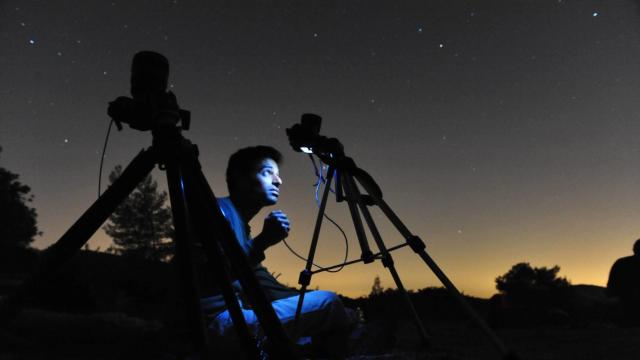To watch meteors streak across the night sky is to witness a humbling, yet fleeting natural phenomenon. And without photos to document the ephemeral wonder of burning rocks screaming through the ether, what will you have to remember your experience of this sporadic occurrence? Will anyone believe you when you tell them you saw the Lyrid Meteors at all? Space pics or it didn’t happen.
But photographing the stars involves more than pointing your phone at the sky. Here’s what you need to know about photographing meteor showers, shooting stars, comets, and other celestial wonders that force us to stay awake and outside when we’d otherwise be in bed.
You need a tripod
When you’re looking to capture something as momentary as a shooting star, you can’t trust the steadiness of your hands. Meteors sail overhead at blinding speeds, which means you need a tripod to take viable photos of them.
“You’ll need [a tripod] shooting at slow shutter speeds,” says Aysia Marotta, a photographer based in Brooklyn, New York. Take it somewhere secluded, far away from any light pollution that might compromise your shots, she says.
Use a wide angle lens
If you’re shooting with a camera, as opposed to a smartphone, Marotta describes the basic necessities for capturing as much of the sky as you can:
“You’re going to want to work with a wide angle lens, so anywhere between 8-16mm is going to capture as much of the sky as possible. Also, F stop is important. Try and bring a lens with an aperture of f/2.8, that way you’re not overcompensating with bumping your ISO.”
If you’re not fluent in the parlance of photography, you can refer to Marotta’s photos, which demonstrate the gorgeous pictures that can result if you’re nailing the basics:
Use infinity focus
Another pointer Marotta recommends is setting your focus to infinity, which will broaden your camera’s depth of focus to its largest possible setting. The sky is big and vacuous, meaning you want to capture as much of it as possible.
Money Maker Photography explains how infinity focus works:
Infinity focus is similar to an extraordinarily wide depth of field. When your lens is focused to infinity, then everything in your frame will be in focus no matter how distant it is to your lens. There are a few caveats to this, however.
Know your environment
Another useful reference point is to understand how meteor showers and related phenomena work. Chris Westphal, an amateur photographer based in Florida who trades in his own stunning night-sky photography, advises setting yourself up under “dark skies with good transparency, meaning a lack of clouds, fog, smog, and haze.”
Westphal notes that meteors usually, “originate from a radiant near the constellation from the meteor shower’s name, so it is good to shoot around those areas.” The Lyrids get their name from the constellation Lyra, which is prominent in the northern sky, especially in summertime. In this situation, the “radiant,” Westphal refers to is the star Vega, which provides the illumination necessary to catch the Lyrids as they blast through the sky. You can usually locate Vega pretty easily, as it’s typically “directly overhead at mid-northern latitudes on midsummer nights,” according to Space.com.
What about smartphone photography?
If you don’t have a camera but still want to try your hand at taking photos of celestial treats, don’t fret: There are plenty of ways to get the most out of your smartphone, whether it’s an iPhone or an Android.
Tom Peet, manager of Repair Outlet, a camera repair business in the United Kingdom, echoes Marotta’s advice when it comes to the necessity of tripods and wide angle lenses, but recommends some smartphone accoutrements that will aid in your pursuit of excellent photos of meteors.
Though your phone’s camera is a marvel of technology in its own right, it’s probably not as good at nighttime photography as your standard DSLR camera. To give your phone snaps a bit of a boost, he recommends downloading a long exposure app, telling Lifehacker:
Long exposure allows your camera to take multiple shots over a period of time – essential for capturing the fleeting nature of meteors. Some free examples include Easy Long Exposure Camera (iPhone) and Long Exposure Camera 2 (Android). While good quality paid apps include Slow Shutter Cam (iPhone) and Night Camera (Android).
Turning off your flash and High Dynamic Range (HDR) are also essential steps. While your flash negates the purpose of shooting in darkness, your HDR poses other challenges.
Peet says:
HDR stands for High Dynamic Range. This setting allows the camera to take multiple shots in a row and combine them to include more light than is visible to the lens in one shot. This can be good for shooting the sky but tends to slow your camera down, which risks missing meteors in the short time they are visible in the sky.
And regardless of whether you use a camera or a phone, make sure to take as many photos as possible. Also, never zoom in — you want to capture as much of the sky as possible.

Leave a Reply
You must be logged in to post a comment.